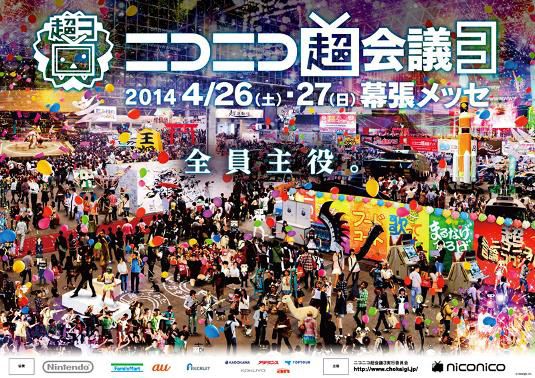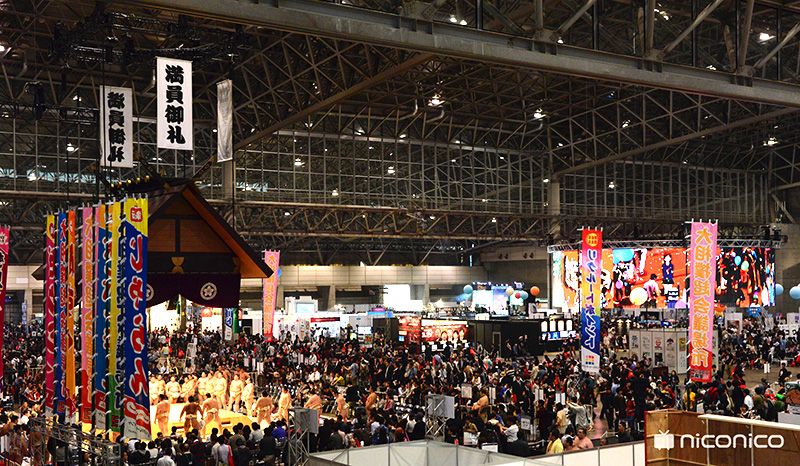
Niconico’s Comment-Enhanced Videos Build Fervent Young Community
Society Culture- English
- 日本語
- 简体字
- 繁體字
- Français
- Español
- العربية
- Русский
Niconico is the most popular video-hosting website among young people in Japan today. Currently the site has around 32 million registered users, 2.11 million of whom pay a ¥540 monthly fee for premium membership. Niconico is similar to YouTube or Veoh in the sense that users can upload videos to be watched by other users, but it has a special feature that accounts for its explosive growth: a function that incorporates viewer comments into the video itself.
 A video on Niconico with a barrage of comments.
A video on Niconico with a barrage of comments.
Unlike YouTube, where comments appear below an uploaded video, viewer comments on Niconico are directly overlaid on the video images. Comments appear at the top of a video, scrolling from right to left like a news ticker or subtitles for a foreign-language film.
Viewers can insert their comments at a precise moment during a video. For example, for a three-minute video, a viewer could insert a comment at precisely the two-minute, one-second point. When other people watch the same video, that inserted comment appears on their screens at that exact moment, too. The result is the feeling that you're watching a video along with others.
Things can get chaotic at times, since comments by multiple users show up simultaneously on the screen. For popular videos, the barrage of comments can be so intense that it becomes almost impossible to see the original content.
A Youth-Driven Online Community
The ability to play an active role through user comments enhances the enjoyment of those who upload content to Niconico, motivating them to post even more videos.
Initially, most of the videos uploaded to the site were either existing content or so-called “MAD movies” created by remixing existing videos. But before long original content also started to appear. Many users uploaded videos featuring themselves singing and dancing.
And that trend toward singing and dancing content further accelerated around 2007, when sales began in Japan of the Hatsune Miku voice-synthesizer software. This "vocaloid" application lets users input notes and lyrics to create a song with a lead vocal and background chorus. Niconico users have flocked to the Hatsune Miku application to create new tunes, and their fervor has produced a number of legitimate hit songs.
The software's mascot, a 16-year-old girl who looks like she stepped out of an anime, inspired the graphical artists among this group. The booming popularity of animated Miku videos to accompany the songs uploaded to Niconico has led in turn to the development of software that turns two-dimensional animations featuring the character into 3D images.
The launch of live broadcasts on Niconico has been popular among users looking for even closer communication. The service allows anyone with a webcam to broadcast via the site. It could be described as the Japanese version of Ustream, the US-based video-streaming service that lets users reach an audience in real time via their PCs or smartphones.
The development of this type of online community has fostered a culture of full participation, where each user is both a creator and a consumer of content. This model of participation creates a knock-on effect, where one person adapts existing content to create something new that then inspires someone else to tweak it again in creative ways. This additive form of creation calls to mind the Japanese literary tradition of creating new poems that make allusions to earlier ones.
Of course, there is a backstory for each video related to whoever created it. And when the allusions to earlier works start to add up, only those “in the know” are able to decipher the meaning. Younger viewers naturally tend to fare better at unraveling such “high-context” content, since they have the time to acquire the necessary background knowledge. And it is also natural that such users of the site would be most passionate about the hard-to-decipher video content that only they are capable of figuring out.
Niconico Chōkaigi: A Real-World Event
 The key visual from the 2014 Niconico Chōkaigi.
The key visual from the 2014 Niconico Chōkaigi.
Niconico is taking the idea of close communication one step further by organizing the annual Niconico Chōkaigi, an event where users can meet each other in person. The third such event was held on April 26–27, 2014, at the Makuhari Messe convention center in Chiba Prefecture.
The 2014 Niconico Chōkaigi was attended by 125,000 people, while 7.6 million watched it over the Internet—record figures for the event. The theme of the event was “A leading role for everyone.” That sort of theme has been featured at many other events, but at Niconico Chōkaigi, it was more than just a slogan.
Many of the individual Niconico users who attended the event were already minor celebrities in their own right, at least in the high-context world in which they have built up relations with each other. These people, who speak their own sort of private language, were clearly excited to actually get together in the real world. The event site featured many displays on topics that are not always popular among young people, like sumō, shōgi, and Japan’s Self Defense Forces, but even these unfamiliar themes sparked new content ideas among members of the Niconico community, adding to the excitement.
 A scene from Niconico Chōkaigi. A Japan-related Internet culture festival, Niconico Kunikaigi, is planned for December in Singapore. (Photograph courtesy of Dwango.)
A scene from Niconico Chōkaigi. A Japan-related Internet culture festival, Niconico Kunikaigi, is planned for December in Singapore. (Photograph courtesy of Dwango.)
Each day of Niconico Chōkaigi ended with a live event called Chō Party, viewed by a million users live online. The performers at the party were not professional singers and dancers, but rather online celebrities. Viewers may not have been familiar with every single performer, but they knew enough background related to the performances to enjoy the live spectacle just the same.
Historically speaking, Japan has had many examples of similarly “high-context” culture. But the Niconico community stands out in terms of the depth of the shared knowledge and the way elements of the real and the virtual are combined. There seem to be few examples of similar communities anywhere in the world.
Kadokawa Teams Up with Dwango
The company that runs the Niconico site, Dwango, integrated its management with the publisher Kadokawa Corp. on October 1, 2014, creating the new holding company Kadokawa Dwango.
Kadokawa was launched in 1945, just after the end of World War II. The company boasts an impressive strategic media mix that includes not only anime and manga, where it has a solid track record, but also books, television programs, and films. Moreover, under its corporate umbrella are nearly all of the imprints of books in the “light novel” genre popular among young people.
Until recently, reading was just an individual pastime. But around the turn of the century, with the popularity of novels read on cellphones in Japan, it became possible for readers to share their impressions of a book in real time, creating a new experience of discussing ideas at more depth within a community.
On the website Pixiv, users can now present their own works of literature, or “Pixiv novels,” to be enjoyed online by other community members. Kadokawa has drawn on the strength of its own media mix—based on the model of adapting the works of fiction enjoyed by individuals into films and TV shows—to offer a way for friends to share content with each other.
A growing trend these days is the adaptation of “light novels” into anime for distribution online, where they spark communities of likeminded fans. The merger of Kadokawa, with its multifaceted content, and Niconico, with its prowess in online content sharing, raises hopes that we will see even more progress in the creation of communities where young people can feel at home.
(Original Japanese article published on October 9, 2014. Banner photo: The April 2014 Niconico Chō Party. Courtesy of Dwango.)